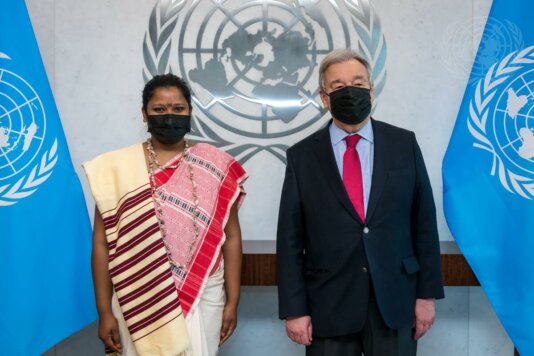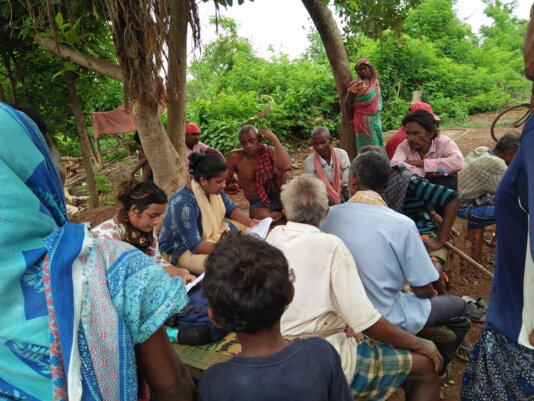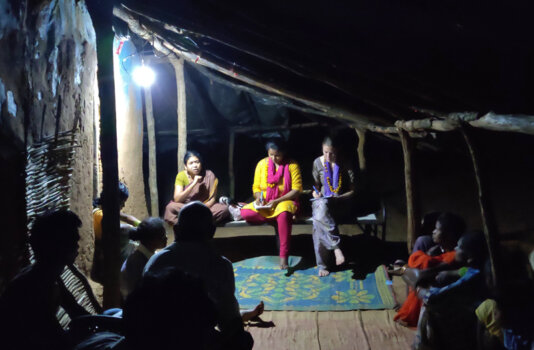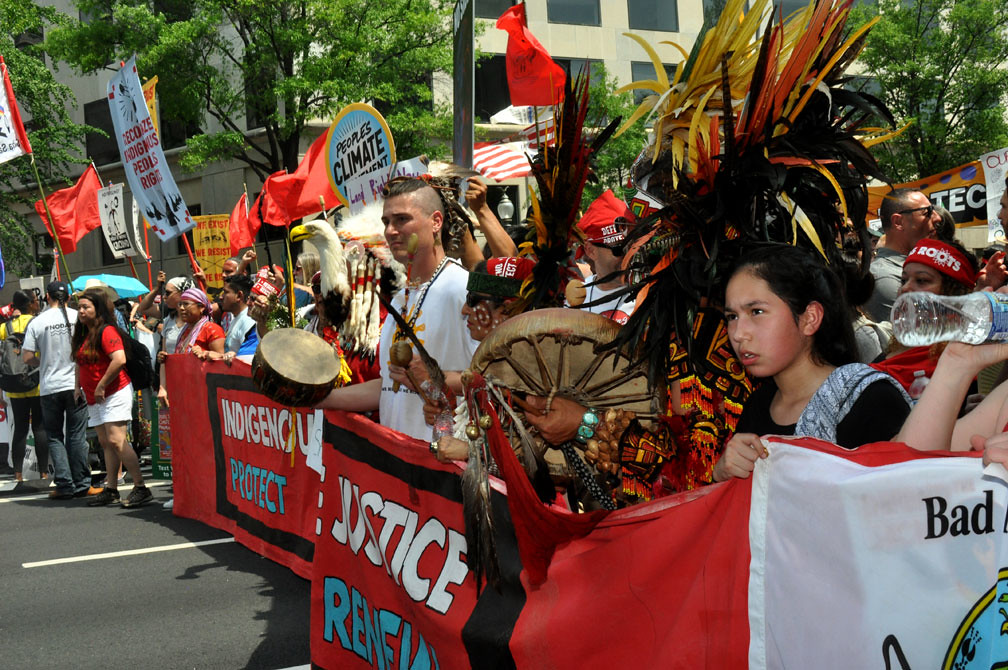- About
- Topics
- Picks
- Audio
- Story
- In-Depth
- Opinion
- News
- Donate
- Signup for our newsletterOur Editors' Best Picks.Send
Read, Debate: Engage.
| April 13, 2022 | |
|---|---|
| topic: | Indigenous people |
| tags: | #India, #indigenous people, #COP 26, #climate action, #climate crisis |
| located: | India |
| by: | Bindu Gopal Rao |
There are over 645 tribes in India. Across the country, these tribes face a slew of issues ranging from reduced control over natural resources, lack of access to education and displacement to rehabilitation, health and nutrition deficiency and erosion of identity.
Furthermore, the urbanisation process in India leads to the establishment of industries that can potentially displace tribes and, as environmentalists point out, increase pollution rates.
In the eastern state of Odisha on the Bay of Bengal, 62 tribal communities face severe poverty and lack of access to education and healthcare.
Archana Soreng, one of the seven members of the UN Secretary General’s Youth Advisory Group on Climate Change, is working with indigenous communities on practising sustainability through ancestral techniques. As one of the few people acting as the voice of Odisha’s indigenous communities, Soreng’s work is both unique and important.
She belongs to the Kharia tribe, in whose language Soreng means ‘rock’. Interestingly, many indigenous communities in the region have surnames related to nature, which attests to their inextricable connection to the natural world.
Nature and the environment played an integral part of Soreng’s upbringing, primarily thanks to her grandfather - a pioneer of community-led forest protection initiatives in her village in Odisha’s Sundergarh district. And while Soreng’s grandfather was a staunch believer in the need to have a sustainable relationship with nature, her father was an advocate of indigenous healthcare.
Women in the region’s tribes have long taken critical roles in protecting nature. In the Kodarapalli tribal village, for instance, it is women who safeguard the forest using a technique called ‘thengapalli’. They gather in groups of four to six and patrol the forest in shifts. This iIs a five-decade old practice aimed at protecting the forest from unauthorised access. They ensure that smugglers, timber thieves and anyone else trying to rob forest resources are caught, thus helping conserve the forests, which are their lifeline.
Archana Soreng spoke to FairPlanet over Zoom from the United Nations headquarters in New York, where she is attending a series of meetings.
FairPlanet: Tell us a bit about your background and what prompted you to become a climate activist.
Archana Soreng: It was my parents who encouraged me to study humanities and environmental science. They felt that if I wanted to further my goal of contributing to society, I had to be part of policy making. This always guided and stayed with me.
It was why I pursued a bachelor's degree in political science and master’s degrees in regulatory governance and worked to be in the policy making field. As my parents were active in the tribal movement for assertion of the rights of adivasi [indigenous] communities, I wanted to do the same.
When I accessed education and pursued environmental regulation, I realised what was written was what I had always seen in my communities - be it about forest protection practices, sustainable living or alternatives to plastic pollution.
I realised that a lot of the practices highlighted were also written by non-indigenous communities, but it is crucial for us to write our history, story and perspective by ourselves. Also, it was important to ensure indigenous peoples are part of the decision-making process, because they are still not integral to it. I strongly believe that indigenous people should be leaders of climate action.
After my father’s death in 2017, I felt the need to learn my tribe’s traditional practices of climate action and biodiversity conservation, and document them for the next generation.
You have been working with numerous tribal communities, can you tell us about the work you are doing with them?
As I am a researcher, I have been doing evidence-based research in terms of documentation of traditional knowledge and practices. I focus not just on not my own tribe, but different tribes like Kondh, Oraon, Santhal, Paudi Bhuyan, Ho and Munda, which also made me realise that while the practices may be different, the perspective is the same, which is protecting nature.
"Indigenous people should be leaders of climate action."
I have been working with several vulnerable groups to understand the practices in terms of nature. I am focusing on the implementation of the Forest Rights Act and working on recognition of rights of indigenous people over their land, seeing how it is critical to have these rights recognised in order to enable them to engage in climate action and learning how they have been affected when these rights are not protected.
We often work on forest-based livelihoods and how these communities are affected by climate crises like cyclones.
Please tell us about the methods they are using to mitigate the global plastic problem.
It is not about what they do, rather, it is about what they have been doing. They have been using twigs from trees to brush their teeth, an alternative to plastic toothbrushes.
In my community, we have water bottles made from bottle gourd, cutlery like plates made of leaves. We have seen how single-use cutlery causes pollution and all of this can be avoided by using natural resources sourced easily and ethically.
Another important aspect of the climate crisis is the need to preserve traditional farming methods that involve no pesticides. The Bonda tribe In Odisha has been doing this effectively and has managed to raise awareness of the iImportance of sticking to traditional farming techniques.
Forest protection methods used by tribes are hardly known and are not documented. What kind of insights do you have about them?
The thengapali practices used to continually monitor the health of the forest are important. There are rules and regulations as well as governance rooted at the village level to ensure forest trees are not cut and what kind of punishment can be given to violators.
These communities also work to ensure that forest fires are mitigated by collecting dried leaves. They make circular holes in between the forest, so that the fire does not spread.
Forest protection is all about perspective; these communities understand the importance of the forest and what it means to them as it is part of their festivals, medicine and even a sense of sacredness.
What do you believe is the significance of indigenous practices and traditional knowledge in the fight against climate change and environmental degradation?
The places where the indigenous people live have better protected forest space compared to other areas. I think it is all about climate justice. Indigenous people have always followed eco-friendly practices, and this was criticised and there was an imposition on them in the name of development.
In the contemporary era, we are acknowledging that the practices of indigenous people and their traditional knowledge are very important to be recognised.
There has been a loss of language, culture and identity of indigenous people. There is an urgent need to preserve the indigenous perspective as they work closely with nature by acknowledging their role in being in the frontline of being impacted by the climate crisis. They need to be part of the decision-making process.
Being part of an indigenous community, can you share what challenges you face?
I am the second-generation learner in my family who has been able to access education. And for me, personally, embracing my identity has been one of my strengths, which was not easy as there have been questions raised about our culture and traditional knowledge methodologies. Initially, I was not comfortable with English and have been mocked for it in school. But I have learnt it is important to articulate yourself.
My community has been doing amazing work that was not acknowledged. It made me want to ensure that their voices are heard, and that their practices are highlighted. I strongly believe that I have been able to access education because of the struggles of my family and my ancestors.
While these are small things, the major challenge which I face is that no one talks about indigenous people. Initially, I felt out of place; but soon I realised that if I do not speak about this, no one else will, as they neither care nor understand it. While I understand my perspective is different, I feel more alone in representing indigenous people.
Tell us of your experience at COP26 and what were some of your key takeaways from the conference?
I participated in the Youth4Climate: Driving Ambition Event as part of PreCOP26 in Milan Italy and COP26 at Scotland as a member of the UN Secretary General’s Youth Advisory Group on Climate Change.
The good part was that I could meet with several representatives of the indigenous communities across the world, which gave me a sense of solidarity. As a young indigenous woman, it was an emotional experience. It was a way of asserting who I am.
I felt that what was lacking is a sense of intersectionality; the focus was on youth largely, but, also, I am a woman and indigenous, and that was not emphasised.
Another important thing is to ensure that there is an enabling environment for people to participate in COP26, as the process makes it more difficult for young people to get accreditation and funding.
If there are initiatives and efforts by the government to have young people and indigenous persons as part of the delegation that participates in COP, it can help make a strong cause for the indigenous community.
Also, many young people cannot access COP due to language barriers, so there is some support required.
You have been vocal about the need for indigenous youths to be included in climate policy and decision-making. Can you share what kind of progress you have made?
I think we have been able to emphasise indigenous people and local communities in the communications and speeches of the UN Secretary General’s Youth Advisory Group.
As far as engagement is concerned, we have been pushing for participation of more indigenous youths and we have been making specific efforts to identify indigenous youth and reach out to them. We keep advocating for the community while meeting with different stakeholders.
What are your future plans?
I really would like to continue giving a voice as an indigenous person, as this needs a lot more attention. I feel I am a ‘field person’, and that is what makes me connected with my roots and the communities.
Although I stay in Bhubaneswar for work, I make it a point to go to my village as part of my field work. I would like to keep learning from the indigenous leaders, as they are here with us today but not tomorrow. If we lose out on their tradition, knowledge and wisdom, it will be very hard. My plan is to go and meet different indigenous leaders in India and Asia.
Image by Archana Soreng
By copying the embed code below, you agree to adhere to our republishing guidelines.



